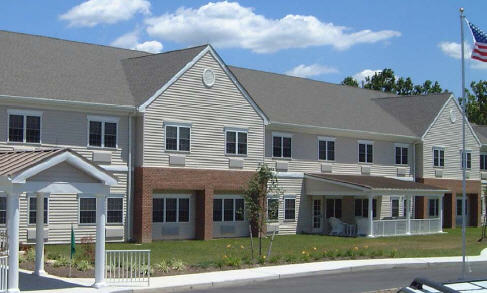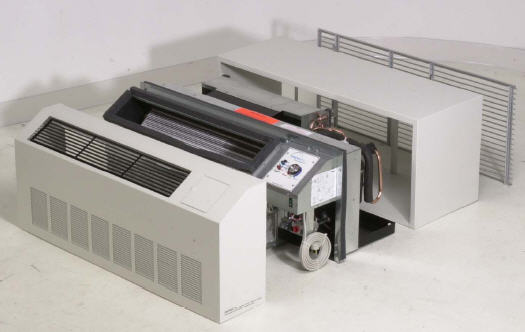Space Heater PTAC
Applications

- Hotels and Motels
- Apartments and Condos
- Multi-family and Assisted Living
- Office Buildings
- Residential Additions
Overview
Packaged Terminal Air Conditioners – PTACs, are self-contained heating and cooling units. Some PTACs can be equipped with a water coil that allows them to heat from a central boiler, and some PTACs are water source heat pumps that use a central water loop as their heat/dump source. However, the most common PTACs are electric air conditioners with electric resistance heating. These are the least expensive to purchase and install on a first cost basis, and are probably the most expensive to operate.
Natural gas options are available for both new construction and retrofit applications. Retrofit applications are relatively easy for the unit itself – as they are designed to be the same size, however, getting natural gas to the retrofit units can be a challenge.
It is becoming more common to see natural gas units installed in northern climates where there is a reasonable payback in operating savings. However, their much higher first cost to purchase and install are a deterrent in moderate and southern climates.
Operations

When a facility is designed and built for PTACs, ‘sleeves’ are installed through the exterior wall where a unit is be installed. The sleeves allow the units to be removed for repairs/service. They are a standard size that allows multiple manufacturers to compete in the retrofit and replacement market. Most PTACs offer a remote thermostat or self-contained thermostat option. Higher-end units can be connected to a network for remote/central operation – such as at a hotel to control unoccupied rooms. Some can be ducted so that an adjacent room can also be supplied from one unit. The units have an outside air damper that can be adjusted for fresh air make-up.
Heating capacity is 12 – 25,000 BTUs and cooling capacity is 0.5 to 1.5 tons.
All electric units typically require 208/240V. Natural gas units still have a cooling side that generally requires 208/240V. Smaller cooling capacity units may only require 110V. For the retrofit market, most any unit can be made compatible with what’s available.
Natural gas units are often piped with flexible gas piping on a 2 psi system. This makes for much easier installation. The units themselves only require standard 0.25 psi gas pressure to operate.
 Economics
Economics
According to Islandaire, the typical natural gas PTAC costs about $1,000 more than an all electric unit installed. Of course, the highest variable is the installation cost of the natural gas piping and wether it’s a new construction or retrofit application. It then becomes a matter of estimating the operating cost difference based on the local climate, the specific application (run hours), and the local utility rates.
Islandaire estimates a 3 – 5 year payback for natural gas units over all electric and heat pump units for typical northern climate installations, where natural gas is more expensive than electricity on a BTU basis.
When estimating the operating cost and savings of one system over another, it is critical to first estimate the operating hours and load factor of the application. Then estimate the energy usage of each unit according to the manufacturer’s data. Be sure to include cooling costs as even in northern climates cooling may be more costly than heating for many applications. Last, apply local utility rates to the estimated energy units.
Manufacturer’s Reps can assist with estimating the run hours and load factors for typical applications in a given climate.
For example, assume a 20,000 BTU unit runs 1,000 hours with a 60% Load Factor.
20,000 BTUs x 1,000 Hours x 60% Load Factor = 12,000,000 BTUs
1 million BTUs of Natural Gas delivered at 80% Efficiency = (Gas Cost per MCF) / 80%
If gas cost is $0.75 per CCF = $7.50 per MCF, $7.50 / 80% = $9.38 per million BTUs delivered
1 million BTUs of Electric Resistance Heat delivered at 100% Efficiency =
1,000,000 / 3413 BTUs/kWh = 293 kWh
If electricity cost is $0.08 per kWh, $0.08 x 293 kWh = $23.44 per million BTUs delivered
Clearly the higher the number of run hours and the load factor, the higher the natural gas advantage.
In the cooling mode, less expensive units will likely have a lower EER rating. However, this should not be assumed. Obtain the actual EER rating of each unit in the comparison. Every one point increase in EER rating is about a 10% reduction in cooling operating costs. Because both natural gas and electric PTACs use electricity for cooling, the difference in EER rating is really the only variable in the cooling cost estimate comparison.
Manufacturers
Islandaire, Inc.
10 Fleetwood Ct.
Ronkonkoma, NY 11779
Telephone: 800-886-2759
web site: www.islandaire.com
 Suburban Dynaline
Suburban Dynaline
Suburban Manufacturing Company
Post Office Box 399
676 Broadway
Dayton, TN 37321
Telephone: 423-775-2131
web site: www.suburbanmanufacturing.com
NorthEast Equipment Sales, Inc.
950 Cherry St.
Kent, OH 44240
Telephone: 330-673-1900
web site at www.dlii.com
